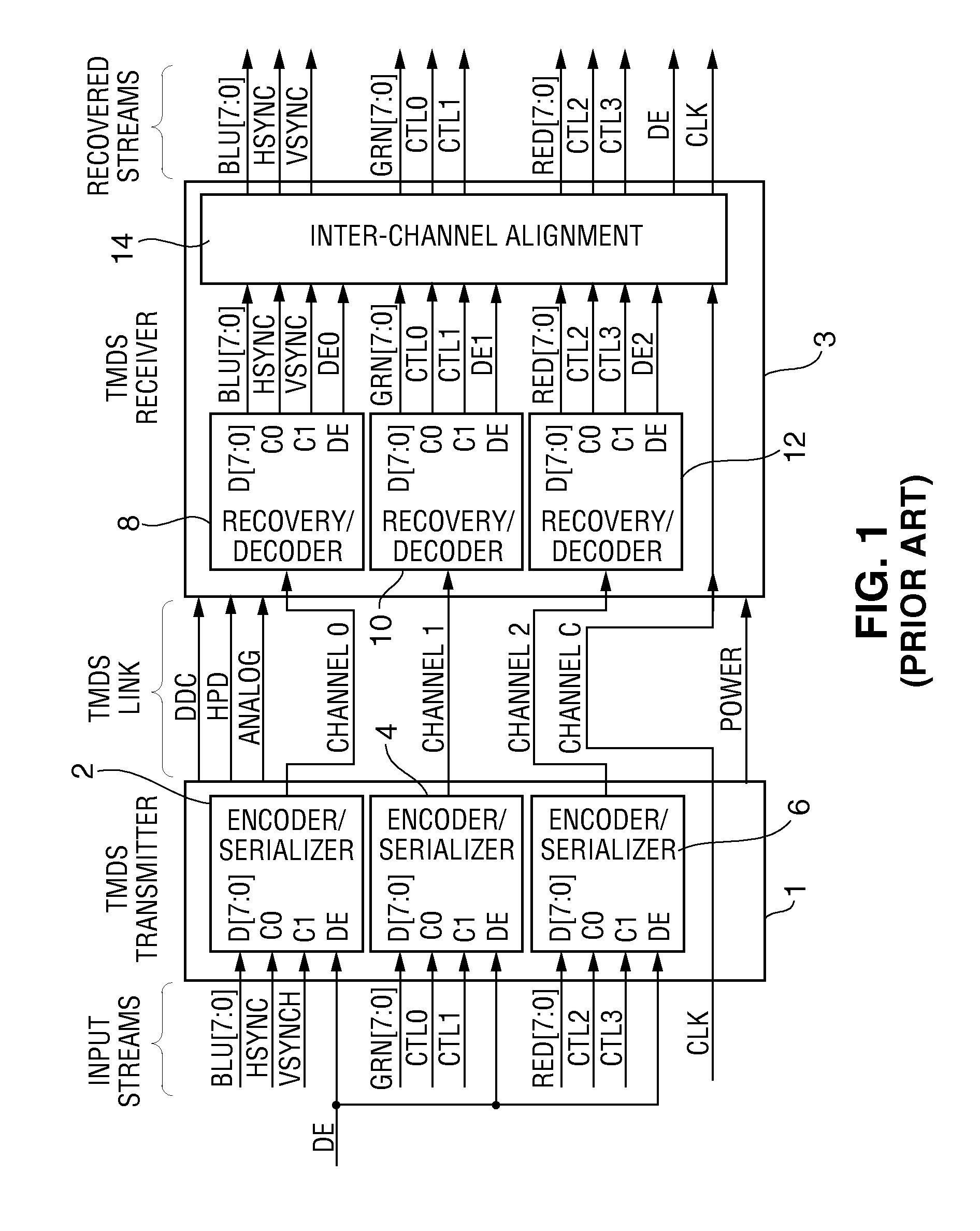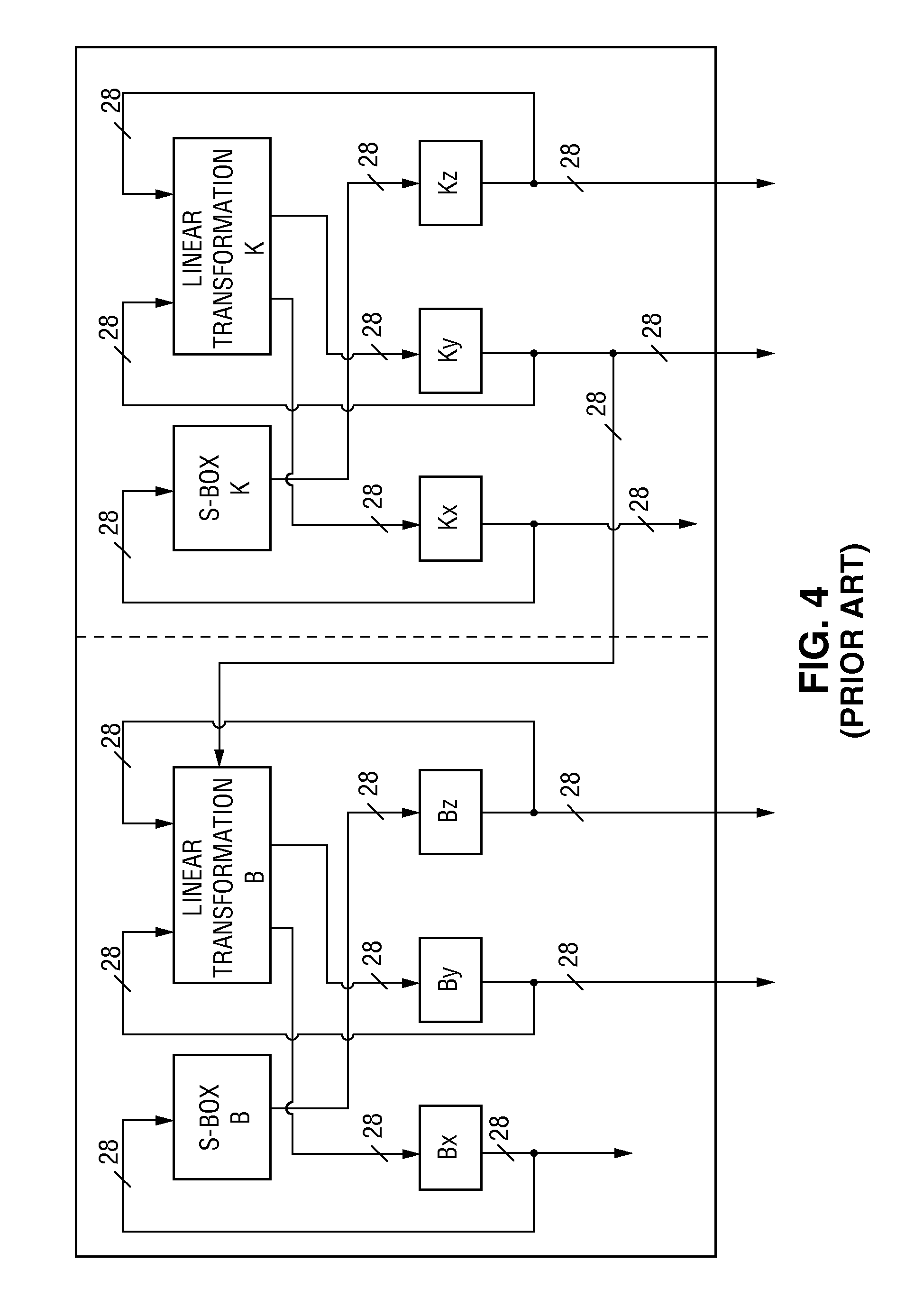[0037]In some embodiments, the inventive cryptographic device also stores
test data (typically indicative of parameters and / or expected test results) for or pertaining to the test key set. For example, in some embodiments the device implements an HDCP protocol and stores
test data indicative of the HDCP session value “An” and test data indicative of an expected result of an HDCP authentication exchange (e.g., the above-mentioned value “R0”). Storage of test data as well as a test key set in the inventive device can allow the device to perform an entire BIST itself and then output a “pass / fail” test result. For example, one embodiment of the invention is a
receiver configured to implement the conventional HDCP protocol (or a modified HDCP protocol that closely resembles the conventional HDCP protocol but differs therefrom in one or more respects) to decrypt data from a
transmitter during normal operation, to store a test key set, a parameter (e.g., a session value “An”) of a type that would be generated by the
transmitter during an authentication exchange, and an expected result of an authentication exchange with a
transmitter (e.g., the value “R0”), and to perform an entire BIST (without performing an authentication exchange or otherwise communicating with the transmitter or another external device) using the stored parameter, expected result, and test key set.
[0039]In typical embodiments, storage of the test key set (and any test data associated with the test key set) can be implemented inexpensively. Since the test key set is not unique to a device, it can typically be stored in simple, inexpensive ROM memory.
[0040]Use of a ROM that stores a test key set (and any associated test data) reduces the cost of implementing the invention. The cost of implementing the invention is further reduced in some embodiments by reducing the amount of data that is stored in nonvolatile memory for use in test mode operation (e.g., a BIST operation), and employing a smaller, less expensive nonvolatile memory to store the reduced amount of data. For example, some embodiments of the inventive cryptographic device store a result (e.g., an intermediate result) of a predetermined operation on a test key set (and optionally also a partial version of the test key set) rather than storing an entire test key set itself. For example, when the device implements an HDCP protocol, the stored result can be the HDCP value “Km,” which is a 56-bit number generated in an
early phase of an authentication procedure. Storing the “Km” value in the inventive device instead of an entire test key set (a 40-bit key selection vector and array of forty 56-bit private keys) needed to generate the “Km” value would prevent the
early phase of the authentication procedure from being tested as readily as it otherwise could be (unless it is tested in a manner other than by using test keys and test data stored in the device), but allows phases of the authentication procedure after the
early phase (and also post-authentication
encryption and decryption operations) to be tested readily using the stored “Km” value and optionally also other stored test keys and / or test data.
[0041]In another class of preferred embodiments, the invention is a cryptographic device including a cache memory. The cache memory is employed to cache an intermediate result of an authentication exchange, or a portion of a key set used to perform an authentication exchange. The cache memory is smaller than would be required to cache the entire key set employed during the authentication exchange. The use of at least one cached key and / or at least one cached intermediate result allows at least one subsequent authentication exchange to be performed more rapidly than it could be performed conventionally. In some embodiments, the device is implemented as an
integrated circuit including non-volatile
semiconductor memory that stores an entire key set. When such a device performs an authentication exchange (e.g., the first one performed by the device), the entire key set is read from the non-
volatile memory and employed to generate at least one intermediate result, and at least one such intermediate result is cached for use in subsequent authentication exchanges.
[0042]For example, in an embodiment in which the device is a
receiver that implements an HDCP protocol, the device reads the entire key set from the non-volatile memory during an initial authentication exchange, employs the key set (with a key selection vector received from the transmitter) to generate an intermediate result (e.g., the shared value “Km”), and caches the intermediate result. The shared value “Km” is well suited to caching since it depends only on the
receiver's keys (which typically never change) and the key selection vector received from the transmitter (the “transmitter KSV”) which very rarely changes in the typical environment. The transmitter KSV and the receiver's own key selection vector (the receiver KSV) can also be cached, or the transmitter KSV can be used to validate a cached shared value “Km.” In a subsequent authentication exchange, the receiver checks whether the newly received “transmitter KSV” matches the cached “transmitter KSV” before retrieving any key data from non-volatile memory. Whether or not the new transmitter KSV matches the cached transmitter KSV, the receiver sends the cached “receiver KSV” to the transmitter (rather than retrieving a KSV from non-volatile memory). If the new transmitter KSV matches the cached transmitter KSV, the receiver uses the cached “Km” value to perform the rest of the exchange (rather than retrieving key data from non-volatile memory to generate a new “Km” value). If the new transmitter KSV does not match the cached transmitter KSV, the receiver retrieves key data from non-volatile memory to use (with the newly received transmitter KSV) to generate a new “Km” value. Typically, the transmitter KSV will change only very rarely during a sequence of authentication exchanges between a receiver and each of one or more transmitters and thus the inventive caching technique typically greatly reduces the average time required to perform each authentication exchange in the sequence. Only a small amount of cache memory is needed since each KSV consists of only 5 bytes and each Km value consists of only 7 bytes. In some embodiments, only a portion of a KSV and / or Km value (or a mathematical hash of a KSV and / or Km value) is cached. This would reduce the size of the cache memory that would otherwise be needed to cache the entire KSV and / or Km value, but would typically do so at the cost of experiencing more false cache hits or implementing additional extra logic.
 Login to View More
Login to View More  Login to View More
Login to View More 


